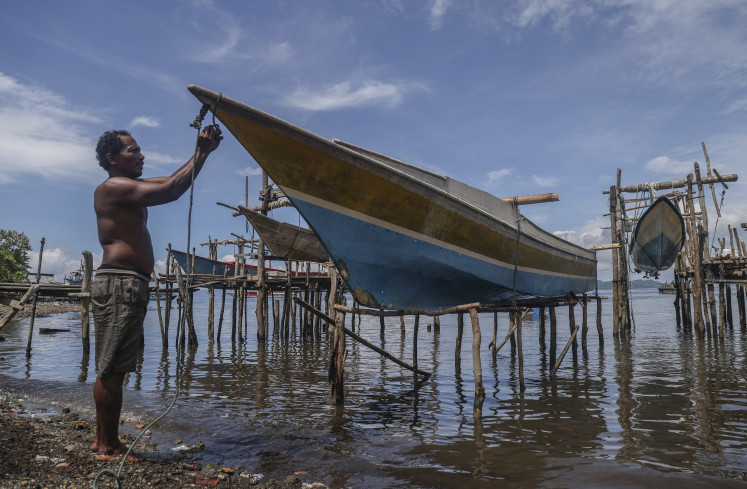Popular Reads
Top Results
Can't find what you're looking for?
View all search resultsPopular Reads
Top Results
Can't find what you're looking for?
View all search resultsTechnology is the need of the hour and beyond
Like many, the healthcare sector’s reliance on digital solutions and technology advancement has risen exponentially. However, in a time of high demand and immense uncertainty, technology in health care is proving to be the need of the hour.
Change text size
Gift Premium Articles
to Anyone
 A medical staff member works with a high detection rate Polymerase Chain Reaction (PCR) machine to screen samples for COVID-19 on April 21, at the Croix-Rousse Hospital in Lyon, central-eastern France, on the 35th day of a lockdown in France aimed at curbing the spread of the COVID-19 pandemic, caused by the novel coronavirus. (AFP/PHILIPPE DESMAZES )
A medical staff member works with a high detection rate Polymerase Chain Reaction (PCR) machine to screen samples for COVID-19 on April 21, at the Croix-Rousse Hospital in Lyon, central-eastern France, on the 35th day of a lockdown in France aimed at curbing the spread of the COVID-19 pandemic, caused by the novel coronavirus. (AFP/PHILIPPE DESMAZES )
A
s Southeast Asia was one of the first few markets outside China to be impacted by the COVID-19 pandemic, a new normal in daily life has emerged for many in this region. To cope with measures to keep the population safe, technology has been integrated into many aspects of daily life. For example, companies have turned to virtual meetings and schools have turned to e-learning. As more people stay home during the pandemic, online food deliveries and online game purchases are booming.
At the center of this pandemic is the healthcare industry. Like many, the healthcare sector’s reliance on digital solutions and technology advancement has risen exponentially. However, in a time of high demand and immense uncertainty, technology in healthcare is proving to be the need of the hour.
Despite being at different states of adoption and implementation, hospitals in Indonesia have been leveraging technology to deliver healthcare for many years. Some examples include the adoption of technologies that can scan patients in a shorter time, lower their exposure to radiation and even provide a more accurate picture of one’s anatomy. Newer technologies include AI-enabled equipment that can automatically position patients for scans allowing the clinician time to carry out more meaningful tasks.
As we move into the digital era, technologies today are focused on helping hospitals deliver healthcare outcomes, improve patient and medical staff experiences, and improve the cost of care. For example, digital solutions integrated into the hospital’s network can automatically summarize a patient’s records to reduce time spent on manual documentation and consultation. It can also provide incremental data points for clinicians to make more informed decisions and predictions about specific cases. Based on an external study done by Frost & Sullivan in Indonesia, the benefits of a digital radiology ecosystem include a 31 percent reduction in turnaround time, a 10 percent increase in diagnostic confidence and ultimately, a 31 percent reduction in cost.
Technology does not only apply to keeping patients out of the hospital but can be leveraged to provide a better experience for those inside. Hospitals in Indonesia and Southeast Asia have been balancing critical care capacity, staffing and affordability as healthcare demand rises. This has given rise to concepts like Smart ICU (intensive care unit) and Tele-ICU, which aim to drive automation, care prioritization and real-time consultations through the integration of patient data across care areas. We have also seen healthcare providers in Southeast Asia leverage Tele-ICU to overcome the spread of rural and urban population in their countries. Tele-ICU expands the reach of specialists, who are typically based in larger hospitals in the city, to ensure patients in provincial or rural areas have access to specialist healthcare services.
As Indonesia fights COVID-19, the above guiding principles for the use healthcare technology is similar but has been urgently compounded by the influx of patients and the need to offer efficient care. For example, hospitals need to carry out scans quickly to isolate patients and to ensure their conditions do not deteriorate. A slow diagnosis could result in a patient requiring more intensive, dedicated care which puts pressure on the hospital’s space, clinical staff and equipment capacity.
Another driver unique to COVID-19 is the use of technology for social distancing. For example, remote monitoring allows the hospital to drive isolation workflows in the ICU. Suitable patient monitors connected to one remote site will allow a doctor to monitor his patient’s conditions collectively without having to make multiple trips to see patients. The isolation workflow can also facilitate the virtual sharing of patient data to the allocated intensivists across departments and in some cases, across hospital locations. Minimizing physical interaction reduces contamination risk and reduces redundancy, allowing intensivists to support the most at-risk patients at specific critical moments.
It is interesting that technology can also be used to support both frontline medical professionals and the equipment they work with. In an environment where there is high patient inflow, hospitals cannot afford for equipment to be out of order. With hospitals limiting the number of visitors to their premises, a service engineer may not be allowed to perform a job on-site. Technology allows engineers to dispense their expertise digitally through augmented reality applications and fix simpler cases remotely.
Data gathered by analytical technology is also a strong ally as it can be used to program scans of equipment usage and its environmental conditions. This provides engineers with a virtual understanding of the equipment’s conditions, with the hospital’s unique environmental factors taken into consideration. Companies use this data to either ensure that they have the parts, resources and tools available at the time of failure or in some instances, ensure replacement parts are proactively procured to ensure the customer does not face any unplanned downtime.
Finally, the convergence of technology and education must continue, even during a crisis to ensure knowledge and best practices are shared speedily across borders. Local medical societies, medical device companies, clinicians and other members of the healthcare community need to continue to work together to deliver knowledge in creative ways.
There is no way to predict how long this pandemic will last. Companies, regardless of sector, have been forced to adopt new practices as part of regular operations for the foreseeable future. If some of these new normal practices succeed within health care, it could spell improvements to outcomes for patients. COVID-19 has disrupted many businesses and industries but I am optimistic that there will be a silver lining for those who persevere.
***
Country director for GE Healthcare Indonesia









